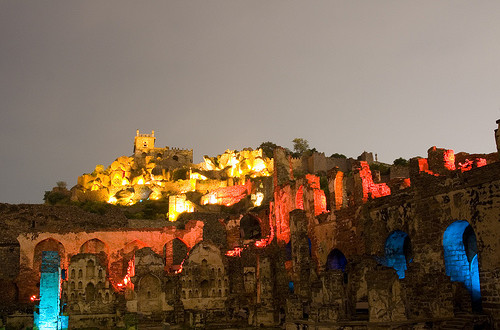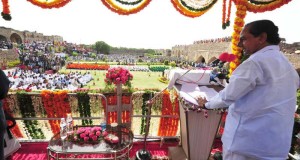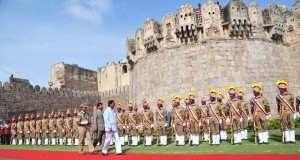With the first-elected government of newly-formed Telangana State having decided on celebration of its first Independence Day from the historic Golconda Fort, Chief Minister K Chandrasekhar Rao on August 15 will hoist the national flag from the Taramati mosque near Rani Mahal inside the fort with Bala-Hissar, the highest point of the fort, providing the backdrop. The State Government has forwarded it’s plans to ASI, which protects the heritage fort, for permission.
“The celebration of Independence day and other state festivals has to take place at Golconda Fort. The main objective behind the celebrations of Independence day at Golconda Fort is revival of Telangana history and culture. Like Red Fort in Delhi, Independence day will be celebrated at Golconda Fort,” the CM said. One of the ancient and biggest citadels, Golconda fort is older than Delhi’s Red Fort. It is also an invincible fortress in that the Mughal emperor, Aurangzeb, couldn’t conquer it even after a nine-month long siege with a one lakh strong army. The TS Government’s effort is seen as a reclamation of the rich heritage of the fort, long sidelined with the ‘Brand Hyderabad’ sloganeering centering around Hitec City. The Independence day event raised big curiosity and is likely to promote Hyderabad heritage in a healthy way. Arrangements are being made in a grand and big scale to reflect history and glory of Telangana culture, the CM mentioned on this occasion.
Hours before the CM visited the place a day ago, narrow lanes leading to Athara Seedhi were cleared of roadside garbage dump and BT roads were re-patched while vehicles parked on the roads were removed. The uneven terrain of Athara Seedhi grounds would be levelled before Independence Day to hold the parade. Officials have been asked to prepare a permanent arrangement for celebration of state and national festivals henceforth.
The historic fort which has been a witness to the vicissitudes that befell this part of Deccan over the last 10 centuries, will now witness the maiden independence day celebrations in Golconda.
Originally, the Kakatiya kings built Golconda as a mud fort between 1083 and 1323 AD. It was ceded to the Bahmani kings in 1365. With the decline of the Bahamani in 1518, Sultan Quli declared independence and founded the Qutb Shahi dynasty, which ruled the Sultanate for 169 years between 1518 and 1687. “It was the first three Qutb Shahi kings – Sultan Quli, Jamsheed Quli Qutb Shah and Ibrahim Qutb Shah – who fortified the Golconda fort with three lines of massive defence walls,” says M.A. Qaiyum, former deputy director, Department of Archaeology and Museums. In fact, the founder of Hyderabad, Mohd Quli Qutb Shah, was believed to have taken birth within the fort.
When Golconda was bursting at the seams with faster economic activity and population growth, the fifth Qutub Shahi ruler Sultan Mohammed Quli Qutub Shah founded Hyderabad as a satellite town to ease the congestion at the fort city. The seventh Qutub Shahi ruler, Abdullah Qutub Shah, extended the Golconda fort by constructing the Naya Qila in 1656. After the fall of Qutub Shahis, Asaf Jahi rulers (1720 to 1948 AD) developed Hyderabad and made it their seat of government, thereby eclipsing the prominence of Golconda.
However, Golconda retains its pre-eminent position as the massive medieval fort which is part of the region’s cultural, social, political and economic heritage. The world famous diamonds, including Koh-i-Noor, Darya-e-Noor and Noor-ul-Ain, were traded in the bazaars of Golconda kingdom whose boundaries included the diamond mines at Kollur in present-day Guntur and Paritala in present-day Krishna district. Golconda symbolised Ganga-Jamuni tahzeeb (the composite culture) that later became the hallmark of Hyderabad. The Qutub Shahi Sultans not only patronized Telugu but also entrusted key positions in the kingdom to Telugus. The rich tradition was continued by Asaf Jahis.
Architects in the city also welcomed KCR’s decision. Freelance architect Haji Jalal Darvish said: “Golkonda has historical roots since Mauryan dynasty. There was a lot of cultural relationship and exchange during the Quli Qutub Shahi rule.” “Similarly, I expect it to be a symbol of cultural exchange during modern times too,” he added.
According to Anuradha Reddy, convener, INTACH, the government’s move would pave way for better recognition of the city’s heritage at international level. “Establishing a new identity by revisiting Kakatiya, Qutb Shahi and Asaf Jahi heritage will do a world of good in terms of getting recognition. The move should lead to better care of the fort,” she said.
Jasveen Jairath, an activist fighting for preservation of Naya Qila, heritage value of the fort should not be compromised and all the sprucing up activities should be done with utmost sensitivity. “It is alright to reclaim Golconda as the symbol of Telangana but care should be taken not to inflict any damage to this long standing symbol of our identity,” she added.
When the Telangana government is in place, it is only proper that it observes Independence Day at a place which reflects the region’s glory. “Golconda Fort is a symbol of the pride of Telangana people. I welcome the decision,” said V. Ramakrishna of A.P. History Congress, echoing the views of many others.
 Telangana Talkies | Leading Telangana News, Movies & Entertainment Portal Website with the latest news from Telangana. We present to the world politics, movies, business updates from Telangana & the capital Hyderabad
Telangana Talkies | Leading Telangana News, Movies & Entertainment Portal Website with the latest news from Telangana. We present to the world politics, movies, business updates from Telangana & the capital Hyderabad




KCR is a genius, of course an apt leader and great statesman. I wonder at his line of thinking, he is not only planning for the future but has full respect for the past.
No civilization has risen which didn’t respect its history. I see Telangana rise as one of the best place to live on the planet.
Hats off KCR! Long live KCR and such ideology.